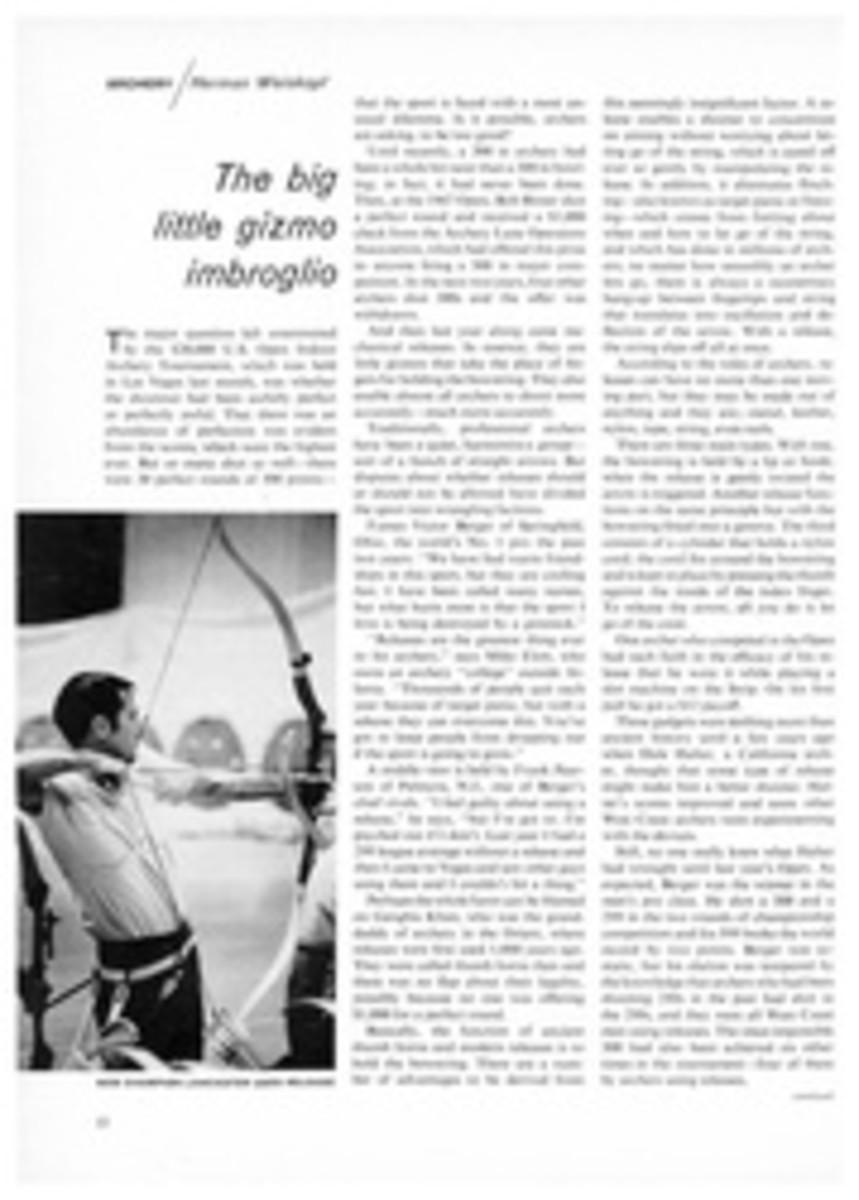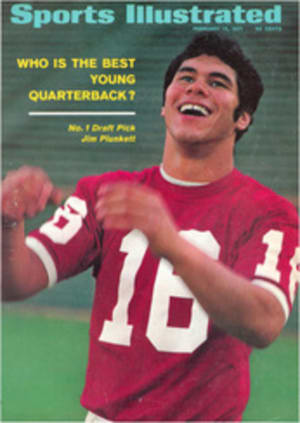
Olympian snafu at Sniktau
For the record, things began to get a bit tense in Denver last May, after the home-town Olympic committee returned from Amsterdam with the big prize: the 1976 Winter Games. This is what Denver wanted; there was a period bathed in the sweet aura of success, congratulations were passed all around and civic pride was duly saluted. But now, nine months later and five years before the Olympics, things are in a marvelous mess.
It all involves the Continental Divide, that bumpy range of mountains that forms America's backbone. The good skiing and settings, the fabulous snow for which Colorado is famous—the conditions perfect for a super Olympics—are on the western slopes of the divide. Denver, unfortunately, is on the eastern slope, where residents have been known to pick wild flowers in February.
And now, beset on all sides by criticism, the Denver Organizing Committee faces the embarrassment of: 1) manufacturing snow for the downhill racers, 2) maybe cutting eight-foot gaps in private backyard fences for cross-country skiers, 3) bulldozing an entire hillside for jumpers, 4) packing throngs of spectators into tiny locations and 5) teaching everybody how to pronounce Sniktau (it is snick-taw).
This situation arose because the International Olympic Committee thought of Colorado in terms of places like Aspen, Vail, Winter Park and Steamboat Springs. And the Denver committee, full of understandable eagerness to get the Games, obviously did not stress the part about the Great Divide. Now, back home, they are definitely catching hell about it.
To land the Winter Games, Denver had to promise the IOC that it would stage all events within a 45-minute drive from the Olympic Village at Denver University. The presentation showing this layout was nothing if not amateurish. Denver proposed Mt. Sniktau as the prime Alpine site, 50 miles out of the city. Sniktau turns out to be a slope known mostly to rock climbers, with a too-narrow base area for parking, a hillside undeveloped because no ski-area developer ever wanted it—and on the east slope of the Rockies. As Pete Wingle, a Denver-based U.S. Forest Service officer, says, "If you and I were going to build ourselves a ski area, we wouldn't put it at Sniktau.
"The mountain's one advantage," he says, "is that it is within 45 minutes of Denver. But the snow cover is not the best, winds can get very bad and there's not going to be much base terrain available for press, spectators or parking." Paul Hauk, another Forest Service officer who helped evaluate the potential sites, warns, "Sniktau has limited future-use potential because it is virtually all expert ski terrain." This is especially bad because the committee would like to save money by letting a private firm develop Sniktau and run it after the Games. One committeeman, Ted Farwell, says, "If there isn't good after-use potential, I think we'd do a lot of soul-searching before developing it for the Olympics."
But the Sniktau snafu is only a starter. The real center of opposition to the Olympics lies in Evergreen, a quiet, manicured, well-to-do suburb surrounded by parkland 20 miles east of Denver. Residents here are shocked at the prospect of having their properties disrupted by the Olympians. For one thing, the Olympic cross-country trails seem to run right through Evergreen's houses and at least one school. Now, Norman Brown, a marketing executive turned Denver Organizing Committee vice-president, says, "Some Evergreen people got turned oil when they saw our maps showing trails going through their homes and the Wilmot Elementary School. Actually, the trails are only eight feet wide and don't go through any buildings—just backyards and the Wilmot schoolyard. Some people would have to let us put gaps in their fences."
The Evergreen people are so furious over the proposal that they have formed a vociferous group called Protect Our Mountain Environment, Inc., and retired law professor and POME Chairman Vance Dittman says, "It's not just that we want to protect the local environment from the bulldozers and parking lots. We're simply convinced that Colorado would be the laughingstock of the world if it tried to stage the Olympic events here in February. Our average daily high that time of year is about 45° and on some days we have weather in the 60s. How can you make and hold snow for a 50-kilometer cross-country course in that kind of climate?"
Well, Committeeman Farwell thinks that maybe 17 million gallons of water daily would provide sufficient snow-making capacity for the Evergreen Nordic courses and ski jumps, biathalon trails, bobsled and luge runs. "We have data that show temperatures during the third week of February generally don't go over freezing until 9 a.m.," he says. "So we should make out all right if we finish the events by 10 a.m."
As if that were not enough, another problem lies in engineering the ski jumps. This would necessitate bulldozing a jump hill and counterslope, rerouting a residential road and laying a concrete outrun across Evergreen's lovely Bear Creek. The idea of putting a wide swath of cement across the meandering stream infuriates the natives even further. Committeeman Norman Brown is a bit uneasy about that. "This plan was drawn by an architect from Chicago. I'm not sure he knew what he was doing," Brown admits.
Despite the fact that the Games are five years away, one immediate result of this uproar is that the Colorado legislature recently put off a request from the committee for a $300,000 supplemental appropriation. State Senator Harry M. Locke, chairman of the assembly's budget committee, says, "We've already given them $475,000 so they could sell Denver to the International Olympic Committee. But they will have to answer a long list of questions for us before they get any more."
It looks like snow-making would be the only solution for the lower elevations of Sniktau and an absolute embarrassment for a state like Colorado—which is what real snow is all about. As for transportation to the competition sites, the favored approach now calls for banning private cars and ferrying tens of thousands to and from the events via private buses. This move came when it grew clear that Sniktau cannot handle the traffic load and Evergreen flatly does not want to. One plan to use Evergreen Lake as a parking lot for 1,800 cars was killed after someone figured out that they would crack the ice and sink from sight.
Right now many experts feel that the only salvation for the 1976 Winter Games is relocation. Richard Taylor, a competitor at Squaw Valley and now a teacher at Denver's Temple Buell College, says, "It's going to look a little silly when foreign stars come thousands of miles and end up skiing on artificial snow in marginal terrain." And, because of the barrage of criticism, Farwell is scouting new eastern slope locations for the Nordics.
But such critics as Dr. Peter Metzger, president of the Colorado Committee for Environmental Information, are not impressed. "The only real solution," he insists, "is to put the Olympics on the western slope."
Evidencing concern, the Denver Organizing Committee is looking at Copper Mountain, an emerging western slope area, as an alternative. Completion of the long-planned Straight Creek Tunnel under the Continental Divide at Loveland Pass would put Copper Mountain within the required time from Denver. But tunnel construction has been hampered by deficits, small cave-ins and a fire.
Through all this storm the DOC sees its current troubles as a minor setback and points to me support of Governor John Love, Denver Mayor William McNichols and the thousands of townsfolk who have donated $2 each to buy Olympic lapel pins. The committee's Bill Brown says, "All the dissident groups are using us as a whipping boy." Later this year the committee expects to bring a delegation of IOC representatives to town to look at all the alternate sites. And if the IOC does not accept a new site? "Well," says Brown, "I guess Evergreen is just going to have to eat it."

